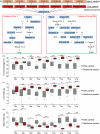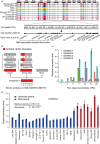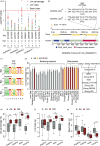Resequencing core accessions of a pedigree identifies derivation of genomic segments and key agronomic trait loci during cotton improvement
- PMID: 30220108
- PMCID: PMC6419577
- DOI: 10.1111/pbi.13013
Resequencing core accessions of a pedigree identifies derivation of genomic segments and key agronomic trait loci during cotton improvement
Abstract
Upland cotton (Gossypium hirsutum) is the world's largest source of natural fibre and dominates the global textile industry. Hybrid cotton varieties exhibit strong heterosis that confers high fibre yields, yet the genome-wide effects of artificial selection that have influenced Upland cotton during its breeding history are poorly understood. Here, we resequenced Upland cotton genomes and constructed a variation map of an intact breeding pedigree comprising seven elite and 19 backbone parents. Compared to wild accessions, the 26 pedigree accessions underwent strong artificial selection during domestication that has resulted in reduced genetic diversity but stronger linkage disequilibrium and higher extents of selective sweeps. In contrast to the backbone parents, the elite parents have acquired significantly improved agronomic traits, with an especially pronounced increase in the lint percentage. Notably, identify by descent (IBD) tracking revealed that the elite parents inherited abundant beneficial trait segments and loci from the backbone parents and our combined analyses led to the identification of a core genomic segment which was inherited in the elite lines from the parents Zhong 7263 and Ejing 1 and that was strongly associated with lint percentage. Additionally, SNP correlation analysis of this core segment showed that a non-synonymous SNP (A-to-G) site in a gene encoding the cell wall-associated receptor-like kinase 3 (GhWAKL3) protein was highly correlated with increased lint percentage. Our results substantially increase the valuable genomics resources available for future genetic and functional genomics studies of cotton and reveal insights that will facilitate yield increases in the molecular breeding of cotton.
Keywords: cotton pedigree; identity by descent (IBD); lint percentage; modern cotton improvement; resequencing.
© 2018 The Authors. Plant Biotechnology Journal published by Society for Experimental Biology and The Association of Applied Biologists and John Wiley & Sons Ltd.
Conflict of interest statement
The authors declare no competing financial interests.
Figures






Similar articles
-
Resequencing a core collection of upland cotton identifies genomic variation and loci influencing fiber quality and yield.Nat Genet. 2018 Jun;50(6):803-813. doi: 10.1038/s41588-018-0119-7. Epub 2018 May 7. Nat Genet. 2018. PMID: 29736016
-
Population structure and genetic basis of the agronomic traits of upland cotton in China revealed by a genome-wide association study using high-density SNPs.Plant Biotechnol J. 2017 Nov;15(11):1374-1386. doi: 10.1111/pbi.12722. Epub 2017 Apr 12. Plant Biotechnol J. 2017. PMID: 28301713 Free PMC article.
-
Identifying favorable alleles for improving key agronomic traits in upland cotton.BMC Plant Biol. 2019 Apr 11;19(1):138. doi: 10.1186/s12870-019-1725-y. BMC Plant Biol. 2019. PMID: 30975072 Free PMC article.
-
Gossypium Genomics: Trends, Scope, and Utilization for Cotton Improvement.Trends Plant Sci. 2020 May;25(5):488-500. doi: 10.1016/j.tplants.2019.12.011. Epub 2020 Jan 21. Trends Plant Sci. 2020. PMID: 31980282 Review.
-
Genome-wide association study reveals novel quantitative trait loci and candidate genes of lint percentage in upland cotton based on the CottonSNP80K array.Theor Appl Genet. 2022 Jul;135(7):2279-2295. doi: 10.1007/s00122-022-04111-1. Epub 2022 May 16. Theor Appl Genet. 2022. PMID: 35570221 Review.
Cited by
-
Dissection of the Pearl of Csaba pedigree identifies key genomic segments related to early ripening in grape.Plant Physiol. 2023 Feb 12;191(2):1153-1166. doi: 10.1093/plphys/kiac539. Plant Physiol. 2023. PMID: 36440478 Free PMC article.
-
Inheritance, QTLs, and Candidate Genes of Lint Percentage in Upland Cotton.Front Genet. 2022 Mar 31;13:855574. doi: 10.3389/fgene.2022.855574. eCollection 2022. Front Genet. 2022. PMID: 35450216 Free PMC article. Review.
-
Unraveling genomic regions and candidate genes for multiple disease resistance in upland cotton using meta-QTL analysis.Heliyon. 2023 Jul 27;9(8):e18731. doi: 10.1016/j.heliyon.2023.e18731. eCollection 2023 Aug. Heliyon. 2023. PMID: 37576216 Free PMC article.
-
Genomic and GWAS analyses demonstrate phylogenomic relationships of Gossypium barbadense in China and selection for fibre length, lint percentage and Fusarium wilt resistance.Plant Biotechnol J. 2022 Apr;20(4):691-710. doi: 10.1111/pbi.13747. Epub 2021 Dec 11. Plant Biotechnol J. 2022. PMID: 34800075 Free PMC article.
-
An RTM-GWAS procedure reveals the QTL alleles and candidate genes for three yield-related traits in upland cotton.BMC Plant Biol. 2020 Sep 7;20(1):416. doi: 10.1186/s12870-020-02613-y. BMC Plant Biol. 2020. PMID: 32894064 Free PMC article.
References
-
- Bradbury, P.J. , Zhang, Z. , Kroon, D.E. , Casstevens, T.M. , Ramdoss, Y. and Buckler, E.S. (2007) TASSEL: software for association mapping of complex traits in diverse samples. Bioinformatics 23, 2633–2635. - PubMed
-
- Brubaker, C.L. , Bourland, F. and Wendel, J.F. (1999) The origin and domestication of cotton. In Cotton: Origin, history, technology, and production ( Wayne Smith, C. , and Tom Cothren, J. , eds), pp. 3–31. New York, NY: John Wiley & Sons.
-
- Campbell, B.T. , Saha, S. , Percy, R. , Frelichowski, J. , Jenkins, J.N. , Park, W. , Mayee, C.D. et al. (2010) Status of the global cotton germplasm resources. Crop Sci. 50, 1161.
Publication types
MeSH terms
LinkOut - more resources
Full Text Sources
Other Literature Sources

